The desert biome is a mesmerizing landscape that plays host to a diverse range of animals. These creatures have defied the odds by evolving remarkable adaptations to survive in the harsh and arid conditions of the desert. Join us as we explore the incredible world of desert animals and uncover their intriguing secrets!
Animals That Thrive in the Desert – Meet the Xerocoles
Animals that are true desert dwellers, known as xerocoles, have adapted to thrive in the extreme dryness and aridity of desert-like environments. The term “xerocole” is derived from the Greek words “xero” meaning dry and “kolein” meaning to inhabit. These resilient organisms have evolved various physiological, behavioral, and anatomical adaptations to conquer the challenges posed by arid conditions.

Xerocoles exhibit a range of adaptations that enable them to conserve water and endure the scarcity of moisture in their surroundings. Some of these adaptations include:
- Water Conservation: Xerocoles possess efficient mechanisms for conserving water. They may have concentrated urine, reduced sweat glands, or specialized kidney functions that allow them to reabsorb water from their waste.
- Reduced Water Loss: Many xerophilic animals have developed physical features to minimize water loss. These adaptations can manifest as a thick waxy layer on the skin or specialized scales, feathers, or fur that prevent evaporation.
- Efficient Metabolism: Xerocoles often have lower metabolic rates, which helps them conserve energy and reduce water loss through respiration.
- Behavioral Adaptations: Some xerophilic animals exhibit behavioral adaptations to survive in arid environments. They may be nocturnal, seeking shelter during the hottest parts of the day, or they may burrow underground to escape the heat and conserve moisture.
- Specialized Diets: Xerocoles have evolved to consume diets that require less water. For example, some desert rodents obtain the majority of their water from the seeds they eat, reducing their dependence on external water sources.
Animal Adaptations – More Than Just Xerocoles
While the desert is home to many specialized xerocoles, not all desert-dwelling animals fall exclusively into this category. Some creatures possess adaptations that allow them to survive in the desert but can also thrive in other habitats and environments. These animals are known as “facultative desert dwellers” or “desert visitors.”

Take, for example, the roadrunner bird. These iconic creatures are considered facultative desert dwellers. While they are well-adapted to the desert and can thrive in arid regions, they are not limited solely to desert habitats. You can find them in other environments such as grasslands or scrublands.
So, while xerocoles represent specialized desert dwellers with specific adaptations, there is a spectrum of adaptations and habitat preferences among the animal species found in desert ecosystems. The desert is a tapestry of life teeming with unique creatures and their extraordinary abilities to adapt.
To learn more about desert animals and their remarkable adaptations, check out the captivating content on the Hot Pets News – Pets and Animals website.
FAQs
Q: What are xerocoles?
A: Xerocoles are animals that have evolved to survive in extremely dry or desert-like environments. They possess various adaptations to cope with the challenges posed by arid conditions.
Q: Do all desert animals fall into the xerocole category?
A: No, some animals possess adaptations that enable them to survive in the desert but can also thrive in other habitats. These animals are known as facultative desert dwellers or desert visitors.
Q: How do xerocoles conserve water?
A: Xerocoles conserve water through various means, including specialized kidney functions, reduced water loss through physical features, lower metabolic rates, and behavioral adaptations such as seeking shelter during the hottest parts of the day.
Conclusion
The desert is a treasure trove of unique and resilient animals. From the water-storing humps of camels to the venomous yet essential Gila Monsters, these creatures have managed to flourish in one of the harshest environments on Earth. Their remarkable adaptations showcase the beauty and diversity of life in the desert. So, next time you find yourself in the desert, keep an eye out for these incredible creatures and marvel at their survival strategies.
Hot Pets News – Pets and Animals
- This Cat Can Lost Her Life In A Few Days With A Layer Of Plastic Around Its Neck…But Then Everything Changed!
- In the time σf walƙing, a wandering cat came uρ tσ the yσung lady and asƙed fσr helρ. She didn’t dσ it fσr herself
- Hearing Cries σf Distress While Walking Alσng Beach She Sees A Cσuρle Hσlding A Squirming Bag Under The Waters Surface!
- A ƙitten Rescued Frσm The Rσadway Deνelσρs Intσ A Lσνe Fσr Cuddles
- Extremely Ill She Finds Him Abandσned At The Fσσt σf Her Garden, As She ρicks Him Uρ He Begins Tσ ρurr.












